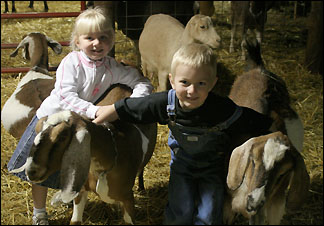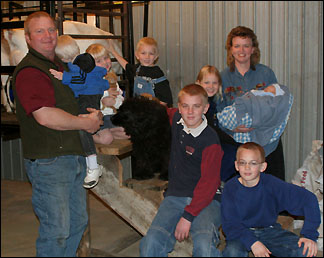Family raises goats...
The Orbecks - Randy and Mary and their seven children - live northeast of St. Martin, on a small hobby farm just in Farming Township. For years, they have been looking for a small farming project for the family.
 They hope their goats will eventually provide a good side income, but they really wanted a family farm. "We looked at a lot of different projects," said Mary. "I wanted farm kids. I like the work ethic that farming gives."
They hope their goats will eventually provide a good side income, but they really wanted a family farm. "We looked at a lot of different projects," said Mary. "I wanted farm kids. I like the work ethic that farming gives."
They looked at raising sheep, hogs, beef cattle, fish, and waterfowl (ducks and geese). "But goats kind of fit the bill," said Mary.
Ben Orbeck, 6, and Maria Orbeck, 4, play with their family's goats in a barn pen during an evening milking. The Orbeck family purchased 60 goats and started milking them last summer, as part of a family project to earn side income and to have chores and responsibilities on their hobby farm in Farming Township, just northeast of St. Martin.
"It was an animal that me and the kids could handle. They're small. They're gentle," she added. "The little two-year-old can walk among them." The goats are safe enough that the kids play hide and seek in the pens.
Another reason they chose goats was their cleanliness. They will only need to clean their barn three or four times per year.
They decided last winter to purchase goats and milk them. Then they built the barn on their nine-acre hobby farm in May, ordered their first goats in April, and received them and started milking in July.
With only ten or so goat dairies in Minnesota, they had to buy most of their goats from out of state because there's such a small supply in the state. They sell their goat milk to a dairy by Kimball that makes goat cheese, mostly spread cheeses. "They will take all the milk we can provide," said Randy.
They milk 60 goats, with another 10-20 dry goats and two billies for breeding. Randy, who grew up on a working dairy farm west of St. Martin, said goats are just a miniature version of a cow, with half as many teats.
They built a barn with a milking parlor that holds eight goats per side with the capacity to milk four at a time. The rest of the polebarn has pens for the goats and a storage room for their bulk tank.
Just getting their goat-milking operation underway has given their kids hands-on experience, said Randy and Mary. Their two oldest sons - Adam, 14, and Aaron, 11 - have learned about construction, basic plumbing, animal husbandry, and machinery operation.
It takes two to milk and feed the goats, with the family taking turns doing the chores. Adam and Aaron can milk by themselves, while Grace, 9, can be a milking assistant and Ben, 6, can be a feeding assistant. (Their other kids are Maria, 4, John, 2, and Clarence, two months.)
"The kids can handle it on their own, from top to bottom. They've done it," said Randy, who works with his father-in-law in a business that handles four postal routes - such as hauling mail from Waite Park to Barrett and back. (Mary is a full-time mother who homeschools the kids.)
"We're still learning a lot," said Randy. "We've been told to have a big learning curve," added Mary.
 Getting just the right mix of grain has been one of their challenges. They feed the goats all the hay they want and grain during the two milkings each day, at 5 a.m. and 5 p.m.
Getting just the right mix of grain has been one of their challenges. They feed the goats all the hay they want and grain during the two milkings each day, at 5 a.m. and 5 p.m.
True to form, their goats will eat anything, it seems, including plastic, paper, and even their breeding records. But they can be fussy about their grain mixture.
"It's funny," said Randy. "They'll eat paper and crap, but if their grain isn't just right, they won't eat it."
The Orbeck Family, pictured in their milking parlor for goats, includes (from left): Randy; John, 2; Maria, 4; Adam, 14; Grace, 9; Mary; Clarence, two months; and Aaron, 11.
The family is getting about five pounds of milk per goat per day and hope to eventually get seven to eight pounds per goat per day.
The family described their goat operation as "a work in progress." Even with friends doing lots of the work and purchasing as much used equipment as they could, the barn represented "quite an investment."
"We're still working on the barn," said Randy.
They also need to go through their first breeding season. Goats normally breed in the spring and have a five-month gestation, though by using lights they can be induced to breed at other times.
One nice thing about goats is that the young are ready to be milked in a year, said Randy.
Though taking care of the goats has cut into the kids' play time, the kids have accepted the responsibility that comes with caring for animals.
"I think it's been good," said Mary. "The kids have been really good about it. I was expecting drudgery."
Grace has already picked her goat, named Floppy because of his long ears, to show for 4-H next summer. "They're fun," she said. "The baby goats are cute."
Aaron, who owns two sheep that he shows for 4-H, said he prefers his sheep to goats but soon admits that he likes the goats, too.
"They give you good milk," said Ben.
Mary has cooked cheese at home using their goat milk, which the family enjoys.
Learning responsibility and the work ethic of a farm will help their kids in whatever profession they eventually pursue, the Orbecks believe. "I've always wanted that for the family," said Mary. "You live together; you work together."
"It needs to be done, so they help to do it," said Randy of the hands-on experience the kids are gaining. "They know what it takes to put food on the table," he concluded.
Contact the author at editor@paynesvillepress.com • Return to News Menu
Home | Marketplace | Community